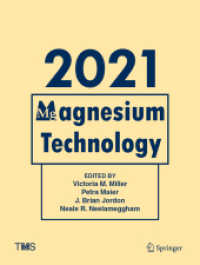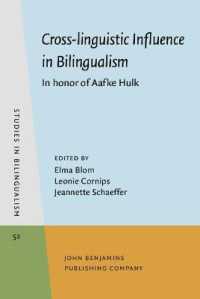基本説明
Experimental Methods in Language Acquisition Research provides students and researchers interested in language acquisition with comprehensible and practical information on the most frequently used methods in language acquisition research. It includes contributions on first and child/adult second language learners, language-impaired children, and on the acquisition of both spoken and signed language.
Full Description
Experimental Methods in Language Acquisition Research provides students and researchers interested in language acquisition with comprehensible and practical information on the most frequently used methods in language acquisition research. It includes contributions on first and child/adult second language learners, language-impaired children, and on the acquisition of both spoken and signed language. Part I discusses specific experimental methods, explaining the rationale behind each one, and providing an overview of potential participants, the procedure and data-analysis, as well as advantages and disadvantages and dos and don'ts. Part II focuses on comparisons across groups, addressing the theoretical, applied and methodological issues involved in such comparative work. This book will not only be of use to advanced undergraduate and postgraduate students, but also to any scholars wishing to learn more about a particular research method. It is suitable as a textbook in postgraduate programs in the fields of linguistics, education and psychology.
Contents
1. Preface; 2. Introduction; 3. Chapter 1. Production methods in language acquisition research (by Eisenbeiss, Sonja); 4. Chapter 2. Using comprehension methods in language acquisition research (by Schmitt, Cristina); 5. Chapter 3. Using Magnitude Estimation in developmental linguistic research (by Sorace, Antonella); 6. Chapter 4. Using infant and toddler testing methods in language acquisition research (by Johnson, Elizabeth K.); 7. Chapter 5. Using Event-Related Potentials in language acquisition research (by Rispens, Judith); 8. Chapter 6. Using eyetracking in language acquisition research (by Sedivy, Julie); 9. Chapter 7. Using on-line processing methods in language acquisition research (by Marinis, Theodoros); 10. Chapter 8. Using computational modeling in language acquisition research (by Pearl, Lisa); 11. Chapter 9. Measuring second language proficiency (by Hulstijn, Jan H.); 12. Chapter 10. Comparing L1 children, L2 children and L2 adults (by Unsworth, Sharon); 13. Chapter 11. Comparing typically-developing children and children with specific language impairment (by Paradis, Johanne); 14. Chapter 12. Measuring the linguistic development of deaf learners (by Baker, Anne); 15. Chapter 13. How to design and analyze language acquisition studies (by Quene, Hugo); 16. Contributors; 17. Index








